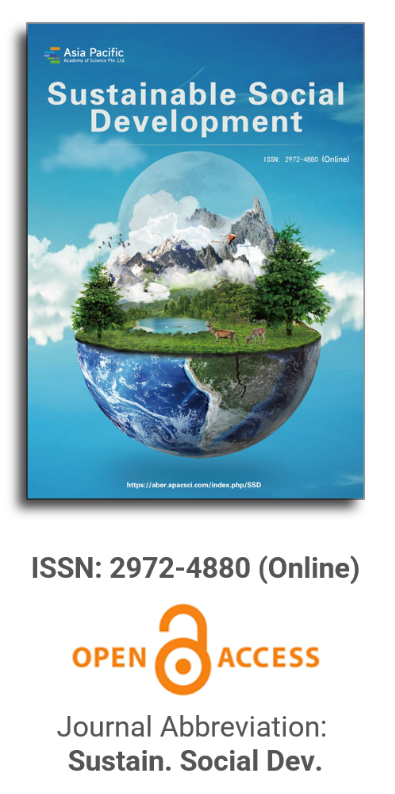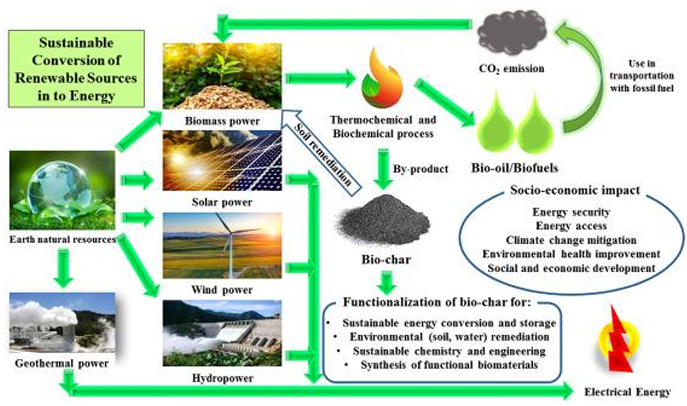
Asia Pacific Academy of Science Pte. Ltd. (APACSCI) specializes in international journal publishing. APACSCI adopts the open access publishing model and provides an important communication bridge for academic groups whose interest fields include engineering, technology, medicine, computer, mathematics, agriculture and forestry, and environment.

Sustainable nutrition
Vol 1, Issue 2, 2023
Download PDF
Abstract
Sustainability refers to the ability to endure and persist into the future. It was initially introduced by the World Commission on Environment and Development through their 1987 report entitled “Our Common Future”. When defining sustainable nutrition, The Food and Agriculture Organization of the United Nations (FAO) places importance on respecting and safeguarding biodiversity and ecosystems, as well as ensuring adequate, reliable, and nutritious food. The global population is presently experiencing rapid growth, which poses a risk of depleting nutritional resources over time. One of the primary objectives of sustainable nutrition is to preserve existing resources for future generations. Achieving this requires careful utilization of global resources. In recent years, there has been a particular focus on researching and altering dietary choices and patterns within communities. The emphasis has been on the applicability of nutrition models that exhibit low ecological, carbon, and water footprints as sustainable nutrition models. Examples of such plant-based sustainable nutrition models include the Mediterranean diet, the Double Pyramid model, the New Nordic diet, vegan and vegetarian diets, the Dietary Approaches to Stop Hypertension (DASH) diet, and the planetary health diet. Additionally, it is crucial to discover alternative food sources that resemble animal protein sources, are accessible to all, and gain widespread acceptance. Currently, the most extensively studied alternative food sources include insects, algae, and cultured meat.
Keywords
References
- Terzi M, Ersoy G. Is sustainable nutrition sustainable for athletes (Turkish)? Journal of Sport and Recreation Researches 2022; 4(1): 21–31. doi: 10.52272/srad.1073827
- Tokay A, Yılmaz C, Bölük S, et al. The Mediterranean diet’s place in sustainability one of the sustainable nutrition diet models. Journal of TOGU Health Sciences 2022; 2(2): 187–201.
- von Koerber K, Bader N, Leitzmann C. Wholesome nutrition: An example for a sustainable diet. Proceedings of the Nutrition Society 2017; 76(1): 34–41. doi: 10.1017/S0029665116000616
- Olgun SN, Manisalı E, Çelik F. Sustainable nutrition and dietary models (Turkish). BANÜ Sağlık Bilimleri ve Araştırmaları Dergisi 2022; 4(3): 261–271. doi: 10.46413/boneyusbad.1188273
- Yüksel A, Özkul E. Evaluation of sustainable diet models (Turkish). Journal of Agricultural Faculty of Bursa Uludag University 2021; 35(2): 467–481.
- Metlioğlu HH, Yakın V. Sustainability in textiles: Sustainability strategies of fast fashion brands (Turkish). OPUS Uluslararası Toplum Araştırmaları Dergisi 2021; 18: 1883–1908. doi: 10.26466/opus.873787
- Engin Ş, ve Sevim Y. Investigation of the relationship between undergraduate students’ behaviors and knowledge levels about sustainable nutrition and food preferences: A single-center study (Turkish). European Journal of Science and Technology 2022; (38): 259–269. doi: 10.31590/ejosat.1109521
- Yılmaz O, Şimşek H, ve Çark Ö. Sustainability Studies (Turkish), 1st ed. Holistence Yayınevi, Çanakkale; 2021.
- FAO, WHO. Sustainable Healthy Diets: Guiding Principles. FAO/WHO; 2019.
- Tunçay GY, Çobanoğlu N. A diet culture developing as a bioethics value: Sustainable healthy diet. Kent Akademisi 2021; 14(4): 1270–1282. doi: 10.35674/kent.968905
- Ricci EC, Banterle A. Do major climate change-related public events have an impact on consumer choices? Renewable and Sustainable Energy Reviews 2020; 126: 109793. doi: 10.1016/j.rser.2020.109793
- Kurtgil S, ve Beyhan Y. Life cycle and the role of sustainable nutrition (Turkish). Düzce Üniversitesi Sağlık Bilimleri Enstitüsü Dergisi 2021; 11(3): 425–430. doi: 10.33631/duzcesbed.866922
- Benedetti I, Biggeri L, Laureti T, Secondi L. Exploring the Italians’ food habits and tendency towards a sustainable diet: The Mediterranean eating pattern. Agriculture and Agricultural Science Procedia 2016; 8: 433–440. doi: 10.1016/j.aaspro.2016.02.040
- Aboussaleh Y, Capone R, El Bilali H. Mediterranean food consumption patterns: low environmental impacts and significant health nutrition benefits. Proceedings of the Nutrition Society 2017; 76(4): 543–548. doi: 10.1017/S0029665117001033
- Gamboni M, Carimi F, Migliorini P. Mediterranean diet: An integrated view. In: Sustainable Diets and Biodiversity. Directions, Solutions for Policy, Research and Action, Proceedings of the International Scientific Symposium Biodiversity and Sustainable Diets United Against Hunger; 3–5 November 2010; FAO Headquarters, Rome, Italy. FAO; 2010. pp. 262–273.
- Can B, Bayram HM, Öztürkcan SA. Solution recommendations for environmental problems: Overview of current sustainable nutrition practices (Turkish). GIDA 2021; 46(5): 1138–1157. doi: 10.15237/gida.GD21062
- Tosti V, Bertozzi B, Fontana L. Health benefits of the Mediterranean diet: Metabolic and molecular mechanisms. The Journals of Gerontology: Series A 2018; 73(3): 318–326. doi: 10.1093/gerona/glx227
- Kadıoğlu S, Sökülmez Kaya P. Environmental and healthy nutrition: Sustainable diets (Turkish). Journal of Samsun Health Sciences 2022; 7(1): 29–46. doi: 10.47115/jshs.948593
- Sotos-Prieto M, Del Rio D, Drescher G, et al. Mediterranean diet—Promotion and dissemination of healthy eating: Proceedings of an exploratory seminar at the Radcliffe institute for advanced study. International Journal of Food Sciences and Nutrition 2022; 73(2): 158–171. doi: 10.1080/09637486.2021.1941804
- Sikalidis AK, Kelleher AH, Kristo AS. Mediterranean diet. Encyclopedia 2021; 1(2): 371–387. doi: 10.3390/encyclopedia1020031
- Tuttolomondo A, Simonetta I, Daidone M, et al. Metabolic and vascular effect of the Mediterranean diet. International Journal of Molecular Sciences 2019; 20(19): 4716. doi: 10.3390/ijms20194716
- Mithril C, Dragsted LO, Meyer C, et al. Dietary composition and nutrient content of the New Nordic Diet. Public Health Nutrition 2013; 16(5): 777–785. doi: 10.1017/s1368980012004521
- Saxe H. The New Nordic Diet is an effective tool in environmental protection: It reduces the associated socioeconomic cost of diets. The American Journal of Clinical Nutrition 2014; 99(5): 1117–1125. doi: 10.3945/ajcn.113.066746
- Kaya Y, Düğeroğlu H, Karataş A, Özbilen M. Effects of DASH dietary and exercise on metabolic parameters in prehypertensive patients (Turkish). Ortadoğu Tıp Dergisi 2018; 10(2): 167–173. doi: 10.21601/ortadogutipdergisi.315813
- Abu-Sawwa R, Dunbar SB, Quyyumi AA, Sattler ELP. Nutrition intervention in heart failure: Should consumption of the DASH eating pattern be recommended to improve outcomes? Heart Failure Reviews 2019; 24(4): 565–573. doi: 10.1007/s10741-019-09781-6
- Wickman BE, Enkhmaa B, Ridberg R, et al. Dietary management of heart failure: DASH Diet and precision nutrition perspectives. Nutrients 2021; 13(12): 4424. doi: 10.3390/nu13124424
- Poyraz SS, Çiftçi S. The effect of Mediterranean diet and DASH diet on the maintenance and sustain of blood sugar levels in the elderly (Turkish). Kırşehir Ahi Evran Üniversitesi Sağlık Bilimleri Dergisi 2022; 6(3): 226–235.
- Willett W, Rockström J, Loken B, et al. Food in the Anthropocene: The EAT-Lancet Commission on healthy diets from sustainable food systems. The Lancet 2019; 393(10170): 447–492. doi: 10.1016/s0140-6736(18)31788-4
- Akay G, Demir LS. Sustainability in public nutrition and environment (Turkish). Selçuk Tip Dergisi Selcuk Medical Journal 2020; 36(3): 282–287. doi: 10.30733/std.2020.01341
- Dixon KA, Michelsen MK, Carpenter CL. Modern diets and the health of our planet: An investigation into the environmental impacts of food choices. Nutrients 2023; 15(3): 692. doi: 10.3390/nu15030692
- Ritchie H. Less meat is nearly always better than sustainable meat, to reduce your carbon footprint. Available online: https://ourworldindata.org/less-meat-or-sustainable-meat (accessed on 11 September 2023).
- Muslu M. Alternative foods of the future in the face of global climate crisis and nutrition problems (Turkish). Climatehealth 2021; 1(2): 78–85.
- Muslu M, Gökçay GF. An alternative resource for supporting health and sustainable nutrition: Algae (Turkish). Journal of Health Sciences and Research 2020; 2(3): 221–237. doi: 10.46413/boneyusbad.795543
- Sürek E, Uzun P. Alternative protein source of the future: Artificial meat (Turkish). Akademik Gıda 2020; 18(2): 209–216. doi: 10.24323/akademik-gida.758840
- Erdoğan B, Görür A, Peksever D, et al. Nutritional characteristics and consumer acceptance of edible insects as a sustainable protein source (Turkish). Gıda Dergisi 2021; 46(5): 1105–1116. doi: 10.15237/gida.GD21074
- van Huis A, Van Itterbeeck J, Klunder H, et al. Edible Insects: Future Prospects for Food and Feed Security. Food and Agriculture Organization of the United Nations; 2013.
- FAO. Looking at Edible Insects from A Food Safety Perspective. FOA; 2021.
- EFSA Panel on Nutrition, Novel Foods Food Allergens (NDA), Turck D, et al. Safety of dried yellow mealworm (Tenebrio molitor larva) as a novel food pursuant to Regulation (EU) 2015/2283. EFSA Journal 2021; 19(1): e06343. doi: 10.2903/j.efsa.2021.6343
- Muslu M. An alternative source for improvement of health and sustainable nutrition: Edible insects (Turkish). GIDA 2020; 45(5): 1009–1018. doi: 10.15237/gida.GD20071
- Demirci M, Yetim H. Consumption of insect proteins as human food and its problems (Turkish). Helal ve Etik Araştırmalar Dergisi 2021; 3(2): 11–22. doi: 10.51973/head.1035367
- Torres-Tiji Y, Fields FJ, Mayfield SP. Microalgae as a future food source. Biotechnology Advances 2020; 41: 107536. doi: 10.1016/j.biotechadv.2020.107536
- Kaba N, Çağlak E. Utilization of marine algae in human nutrition (Turkish). Journal of Fisheries & Aquatic Sciences 2006; 23(1/2): 243–246.
- Cai J, Lovatelli A, Aguilar-Manjarrez, J, et al. Seaweeds and Microalgae: An Overview for Unlocking their Potential in Global Aquaculture Development. FAO Fisheries and Aquaculture Circular; 2021.
- Yetim H, Tekiner İH. A critical evaluation of artificial meat production phenomenon among alternative protein sources (Turkish). Helal ve Etik Araştırmalar Dergisi 2020; 2(2): 85–100.
- Shen YC, Chen HS. Exploring consumers’ purchase intention of an innovation of the agri-food industry: A case of artificial meat. Foods 2020; 9(6): 745. doi: 10.3390/foods9060745
- Chriki S, Hocquette JF. The myth of cultured meat: A review. Frontiers in Nutrition 2020; 7: 7. doi: 10.3389/fnut.2020.00007
- Roser M, Ritchie H, Rosado P. Food supply. Available online: https://ourworldindata.org/food-supply (accessed on 11 September 2023).
Supporting Agencies
Copyright (c) 2023 Hatice Peker, Ahmet Murat Günal
License URL: https://creativecommons.org/licenses/by/4.0/

This site is licensed under a Creative Commons Attribution 4.0 International License (CC BY 4.0).

Prof. Kittisak Jermsittiparsert
University of City Island, Cyprus





It is with deep regret that we announce the cancellation of the Forum on Sustainable Social Development & Computing and Artificial Intelligence, originally scheduled for June 15, 2025.

